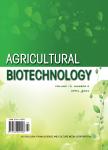Mophological and Molecular Identification of Potato Cyst Nematode from Sichuan,China
作者机构:Technical Center of Chengdu CustomsChengdu 610041China Technical Center of Ningbo Customs/Ningbo Inspection and Quarantine Science Technology AcademyNingbo 315100China Ningbo Joysun Product Testing Service CompanyNingbo 315100China Institute of Plant ProtectionSichuan Academy of Agricultural SciencesChengdu 610066China College of Agriculture and BiotechnologyZhejiang UniversityHangzhou 310012China
出 版 物:《Agricultural Biotechnology》 (农业生物技术(英文版))
年 卷 期:2022年第11卷第5期
页 面:42-49页
学科分类:09[农学] 0904[农学-植物保护] 090401[农学-植物病理学] 090402[农学-农业昆虫与害虫防治]
基 金:Supported by Sichuan Science and Technology Program (2021YFN0009) Science and Technology Project of General Administration of Customs(2020HK161) Key Project of Ningbo Public Welfare Science and Technology Program (2021S024) Technology Development Project of Ningbo Joysun Product Testing Service Company (2020ZS003)
主 题:Potato cyst nematode Morphology Molecular identification Quarantine Identification Monitoring
摘 要:[Objectives]The infection symptoms of cyst nematodes were found in Yuexi, Sichuan. In order to identify the pathogen, the isolated nematodes were identified by morphology and molecular biology. [Methods] The potato roots and soil around the roots were collected, the nematodes in the roots were stained and observed, and the cysts were separated by the simple floating method. The second-stage juveniles(J2 s), females and cysts were found, and they were photographed and morphologically measured. The DNA of cysts and J2 s were extracted and identified by species-specific PCR. The DNA sequences of 18 S gene, 28 S D2-D3 region and ITS region in ribosomal DNA were obtained. Sequences of some cyst nematode species were downloaded from GenBank for sequence alignment, and MrBayes 3.2.3 software was used to construct a Bayesian phylogenetic tree. [Results] The nematodes could invade hosts’ root system. The basal knobs of J2 s was nearly round and inclined backward;the average length of the stylet was shorter than 23 μm;the Granek ratio of cysts was greater than or equal to 3, which is highly consistent with that of Globodera rostochiensis. The DNA templates of three cysts and four J2 s were amplified by species-specific PCR, and a band of about 430 bp was obtained. After further sequencing, the length was 434 bp, which is consistent with G. rostochiensis. The evolutionary analysis of rDNA 18 S and 28 S showed that the cyst nematode population was a Globodera species, and further evolutionary analysis of ITS gene confirmed that the population was G. rostochiensis. [Conclusions] The nematodes are G. rostochiensis, which is a quarantine species of great concern to both domestic and import quarantine. Once introduced and colonized, it is hard to eradicate. It is necessary to establish a monitoring system as soon as possible, strengthen the quarantine, supervision and management, increase investment in G. rostochiensis research and development, and develop detection and control tec



